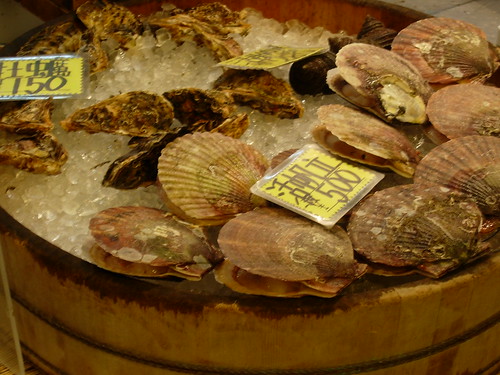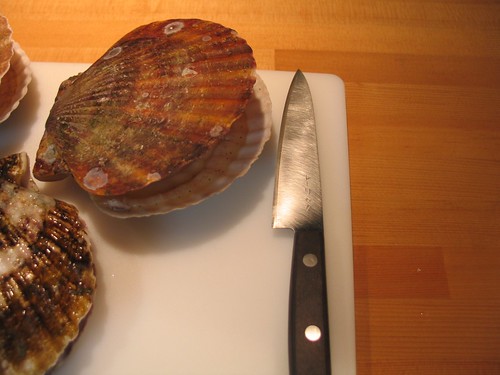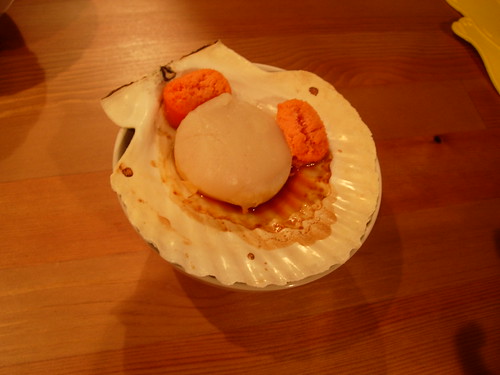So I’m in Nishiki market buying a bunch of stuff the other day. Nishiki is this amazing place where you can get pretty much anything that appears in remotely traditional Japanese food. It’s a whole bunch of little stalls, most just 6-10 feet wide; this egg place is literally something like a meter wide, and the nice lady has to go into the back to get stuff for you because she doesn’t have almost any display space.
Nishiki market runs for several blocks, covered, blocked off from traffic — and now also from smoking, which is a definite plus around food!
I’d already gotten pretty much everything I needed and I was just looking for something extra, some neat thing that wouldn’t cost too much but would be fun. And I spotted, way at the west end of the market, a guy who does mostly shellfish. He’s got this big tray of ice, on which he’s got live oysters and the most beautiful live scallops I’ve ever seen. They’re $4.75 apiece, which isn’t much considering they’re huge.
Hey, I can shell a scallop — they say it’s the easiest hardshell to do, so I can learn from good instructions. I’ll cut them, then broil in the shell with some pollack roe, because scallops usually don’t have decent roe of their own and I want the richness without mayonnaise and cheese and stuff. The nice man carefully chooses three good ones and packs them into a paper bag with a little plastic thing of ice, puts that in a plastic bag, and I head off home.
So about 45 minutes before I want to serve dinner, it’s time to get those suckers out. I’ve read that you don’t do it more than an hour in advance because they don’t stay fresh. So, out come the scallops and a very, very sharp paring knife. This photo shows both: that’s a 4.5-inch blade, so you can see how big the scallops are.
Since you almost never see scallops live in American markets, I’d never shelled one myself, but I knew what to do. Here’s the basics: You hold it right-side up, and since the mouth tends to gape you can just reach into the upper shell with a paring knife. You cut between the adductor muscle, which is the big part you eat, and the shell. This releases the shell, which you pull off, and then you scrape the bottom clean in the same way. You only eat the adductor muscle, which looks like what you think a scallop looks like: a white cylindrical blob. If there is red roe, you eat that too, but that’s not usual except in one or two Atlantic species. The rest you chuck.
You might think chucking that stuff is wasteful; after all, you’re chucking essentially 100% of the stuff you eat in a mussel, clam, or oyster. But this actually makes the scallop probably the safest bivalve to eat raw: the danger usually comes from the fact that you’re eating a filter, something that eats by sucking things (including nastiness) out of the water. But with a scallop, you only eat the adductor muscle holding the shells together, and you chuck the filter part. (Though in Europe and Japan they usually eat the whole thing.)
So, armed with this knowledge, I grabbed my beautiful scallop and my beautiful handmade knife. In goes the knife, and snap! The thing closes, hard. After a good bit of work, I extricate the knife. I’m not kidding: this thing was really gripping the knife! I try again, this time coming in from the side, where there’s a bit of a gap. I can get the knife a couple inches in, but to get farther the scallop needs to open, and it doesn’t want to. I don’t want to screw around here, because I don’t want to hack the flesh to bits, and besides that knife is frighteningly sharp, so if I slip badly I could literally lose a fingertip. Finally, working as carefully and quickly as I can, I manage to cut above the muscle enough that it starts to let go on one side, but it’s still fighting. Not wanting to kill myself with the knife by yanking or something, I shift to the opposite side, cut-scrape some more, and suddenly uuhhhh it lets go. Now scrape scrape scrape and it all goes in a little bowl for trimming later.
I’m thinking, okay, this is a mutant scallop, right? I mean, I have never had trouble like this with clams, mussels, lobsters, crabs, or whatever. Oysters I have only opened once, but there it’s just a bit of hard pressure and pop! So, on to the next scallop. It’s equally feisty. I’m expecting it, though, so I have a strategy, but it’s still a fight. Same with the final one. If that knife were blunt, I’d have shredded the meat just trying to open the damn thing, and god knows what I’d have done if the blade had been short.
Okay, so far so good. A little surprising, but at least they’re really fresh. Right?
Next I scrub the shells very well with soap, rinse thoroughly, and boil the hell out of them for ten minutes. This is because I’d like to use them as little dishes, you see. Once those shells have cooled and drained in a colander for a while, it’s time to trim the meat and get these puppies under the broiler. What with one thing and another (I had most of a meal to prepare at the same time), it’s been about 30 minutes since the shell fight.
I reach in to the bowl for one of my pals and scoop it out. Suddenly it sort of jump-pulses in my hand. It’s still alive and fighting! Now I’m getting a little freaked. Fresh, yes, but what they hell? I cut and trim as fast as I can, again with my very sharp knife, and it keeps pumping just when I least expect it. Finally I’ve cut enough that it stops moving — mostly: I can still feel it twitching just a bit as I finish up and dump it in a shell half. With some trepidation, I reach for the next... which starts throbbing. I’m expecting it, so I’m quicker, but it’s still weird. The last one, I’ve figured out what to cut first to stop it from jumping around, so it goes more smoothly, but it’s definitely alive.
Let me explain. When I say “jumping around,” imagine you’re holding a small frog or toad or maybe a big goldfish, gently but firmly, almost entirely enclosed in your fist. You thought it was dead, but now it decides it wants no part of whatever you’re up to and makes a break for it. Got it? Can you imagine it suddenly coming to life and starting to squirm? I know it’s just a muscle and a very simple nervous system, but it sure seemed like these scallops were trying to escape. I’m reminded of the heart transplant in the movie Airplane, which keeps bouncing up and down on the doctor’s desk.
Well, at least they’re fresh!
After all that excitement, the actual cooking part was nothing. I put one scallop each the three deepest shell halves and added two 1 cm slices of tarako, which is salted fresh pollack roe. Then a sprinkle of salt, a small dash of soy, and a squeeze of sudachi lime. I ran them under a sorta hot broiler about 3 minutes until the top was just opaque, the inside raw, the underside nearly so — I sure wasn’t concerned about freshness! Ta da, serve immediately.
Very good, I thought. Next time I’d add only one piece of tarako and something else, maybe a little sabayon or homemade mayonnaise or crème fraîche, to add a different, less salty richness, as the combination of richness and salt was a little too forceful against the subtly briny scallop. Cheese seems like overkill. Regardless, scallops this fresh are really fabulous. And at $4.75 per scallop for big honking diver-harvested things like this, I’d do it again in a minute.
I have since found that I did one thing wrong, and that there is a strong difference of opinion about another. The thing I did wrong: you always go in from the side, right by the hinge, not from the front, so the scallops can’t just clamp down on the knife like they did to me. The other thing: some people say you want a sharp knife like I used, but others say you want a butter knife and just scrape the muscle off the shell. That way you can’t shred the meat, you see, and can be pretty rough with the scallop. That system seems to be more popular with bay scallops, which are little, but it does get used with big sea scallops. Next time I’ll try both methods and see which works best for me.
Regardless, next time I’ll be prepared for a fight. Who’d have thought scallops would beat out crabs and lobsters for basic toughness and bad attitude?




No comments:
Post a Comment